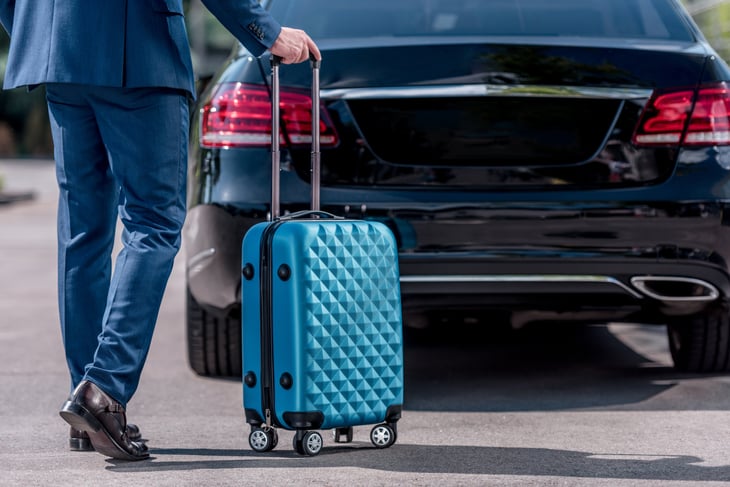
A savvy shopper just hates to pay retail. Luckily, you usually don’t have to: A few basic money moves can help you find the best price always.
There are also tools like Rakuten, which can get you up to 40% cash back when you shop online, for example.
And there are definitely things for which you should never pay full price. That is, unless you’re determined to waste your hard-earned money.
That list is pretty long, so we’ve narrowed it down to some of the bigger-ticket items. Seriously: Don’t pay the rack rate on any of these things.
1. Vacations

Full-priced airfare, hotel rooms and car rentals are like bears in the wilderness: We know they’re out there, but no one wants to encounter them.
Instead, do everything you can to avoid paying retail. Keep watching for the lowest plane fares and lock in the best price you can, as soon as you know where you want to go.
Speaking of which: Unless your destination is set in stone, consider branching out. Sites like Priceline, Orbitz and Hotels.com can introduce you to hot deals in cool places you might never have heard of before. That deal might be a great airfare or an entire travel package.
Save a bundle with a discounted sightseeing pass like those from CityPASS; some of them even let you skip the line at hot tourist attractions.
Remember that “lodging” doesn’t always mean “hotel.” Consider a vacation home rental, with help from sites like FlipKey, Homestay.com and VRBO. Depending on the city, you can save a bundle this way – especially if you’re traveling with family or friends.
Cash in rewards points from customer loyalty accounts or rewards credit cards to get free airfare or lodging. Traveling during specific time periods can also bring great deals.
Not sure which rewards credit card to get? Visit the Money Talks News Solutions Center and search for a great card.
2. Mattresses

Start by researching what kind of mattress you want (there’s a lot of variety out there) and then hit the store.
Once you’ve identified the right mattress type, use these strategies to find the best deal:
- Compare products. Both Costco.com and Amazon are good sources.
- Ignore the hype. Salespeople have one job: to sell you something, right then, before you can leave the store. You might not need bells and whistles. Keep your options open — which might mean waiting for a big sale.
- Note the return policy. If a store won’t take back a mattress that doesn’t work for you, shop somewhere else.
- Prepare to haggle. Consumer Reports says that while warehouse clubs generally have fixed prices, almost no one else does. Don’t be afraid to walk away from a store that won’t even consider a discount. At the very least, you might get some free linens and pillows added to the deal.
We share more in “7 Tips for Buying a Great Mattress at the Right Price.”
3. Luggage

Traditionally, luggage has gone on sale in March, shopping expert Trae Bodge tells Money Talks News. That’s when new cool designs and innovations are introduced by luggage-makers, which means that stores need to get rid of last year’s stuff. A couple of other good times are late July and early August (as summer travel winds down), as well as Black Friday and Cyber Monday.
You can likely get a decent deal at any time, though, thanks to online retailers. Right now – before you actually need the suitcase or duffel – is a good time to start looking. Using a website like Shopzilla or PriceGrabber lets you compare apples to apples, cost-wise.
Don’t forget discount retailers such as T.J. Maxx or Marshalls. Bodge says: “The styles won’t be the current seasons (but) what really matters is the size, the quality and the functionality.”
4. Gym memberships

You don’t need to pay full price – or maybe anything at all – to get healthy and fit. For example, in the interest of employee wellness, some companies reimburse workers for some or all of their gym fees. Other employers arrange discounts with local gyms. Ask!
Feel like mixing it up? ClassPass lets you try everything from yoga to cycling to boxing at local studios. It offers a one-month free trial.
If you’ve got a smartphone, you’ve got a fitness coach. Depending on the app, you’ll get encouragement, calorie counting and nutrition tips. There are apps for people who don’t have much free time (7-Minute Workout), apps that help you do good (Charity Miles) and even apps that let you bet on your weight-loss goals and win money if you meet them (HealthyWage).
In other words, you might not need a gym at all.
Want more tips? See “7 Ways to Save on a Gym Membership.”
5. Furniture

Seems like furniture sales go on all year long. But you might be able to get a better deal than the “rock-bottom prices!” being advertised.
Start by asking, “Is this your best price?” Or say, “I would buy this sofa today if the price were X dollars lower.” You might luck out.
Estate sales, consignment stores, thrift shops and Facebook Marketplace might also yield deals. So might Freecycle and Craigslist. Some people won’t buy upholstered furniture that way, fearing that fleas or bedbugs might come along with the deal. But plenty of wood furniture ends up in those places.
Keep an eye out for Groupon deals, too. One guy we know paid $50 for a $100-off coupon at a furniture store and was able to combine it with a sale to get a very nice price on a very comfortable rocking recliner.
More deal-snaring tactics can be found in “12 Ways to Slash the Cost of Furniture.”
6. Televisions

Televisions tend to be most affordable in November and December, particularly on Black Friday and Cyber Monday. But according to CNET, it’s not just a question of “When are TVs the cheapest?” but also a question of value.
“(The) TVs that get the huge discounts are usually either no-name brands, or low-end models from name brands. They’re fine if you just want a cheap TV, but they’re not going to offer the picture quality of an even slightly higher-end model. “
Even though the best models may go on sale, you probably won’t save much. Deep discounts aren’t common because TVs generally don’t have a high mark-up, says CNET. More to the point, major electronics companies don’t permit much price-tweaking: A TV from Best Buy is going to cost more or less the same as the ones at other stores.
Do your research and watch for late-fall price drops. Consider setting a deal alert at a site such as Slickdeals and be ready to pounce. While you wait, put it out in the universe that you want a TV; a relative or friend who’s upgrading might be looking to unload their old one. Your taking it off their hands will save them a disposal fee.
An important piece of advice from CNET: Ask yourself whether you need to buy at all.
“If your TV works and you’re happy with it, keep it. Don’t feel any pressure to upgrade.”
7. Cars

Do your research before you ever step foot in a dealership. Automotive website Edmunds.com suggests calling, emailing or texting some dealers in your area to get a price range. The site has a price-checker tool for new cars so you can see whether you’re being offered a good deal.
When you arrive on the car lot, let salespeople know you are not buying today because you’re still comparing and test-driving. Don’t do those things while tired or hungry, by the way: You want a clear head for this transaction.
Never, ever answer the question “What monthly payment would work for you?” That’s one way a salesperson can sell you more car than you need.
Instead, ask a question of your own: “What’s the out-the-door price?” That means the vehicle cost plus things like sales tax, title and registration, and the documentation fee.
Find more money-saving info at “8 Tips for Buying Your Next Car for Less.”
8. Appliances

Research. Research. Research. Find out all you can about the appliance(s) you need and what features you want versus those you can do without.
But don’t get hung up on a particular appliance brand. Just because your foodie friends all have Subzero fridges or six-burner Viking stoves doesn’t mean you need one.
Even if you’re pretty sure about what you want, ask the salesperson for recommendations – they might have something just as good (or better) for your needs that costs less and has a good reputation.
Be on the lookout for scratch-and-dent models too. One woman we know asked for a deal on a slightly damaged fridge. Since the scratched area was going to be against a wall, she didn’t care how it looked – and the salesperson knocked off more than 50%.
9. Lawnmowers

These grass-eaters can be scary-expensive, but high cost doesn’t necessarily mean the best deal, according to Consumer Reports:
“Some models cost hundreds – even thousands – of dollars less than our top-scoring machines, yet they perform almost as well. But our tests also show that paying just a little more can often buy a lot more mower, especially at the lower end of the price spectrum.”
Push mowers, as opposed to self-propelled models, tend to be more affordable. And early fall is the best time to buy, according to HGTV:
“Retailers are desperate to make room for their holiday inventory, and your new mower will probably be marked as far down as it’s ever going to go. If you’ve found what you want, you’re not going to get a better deal than the one you find in September/October.”
If the salesperson seems really eager to close the deal, go ahead and ask for a discount. Can’t hurt, might help.
10. College textbooks

Textbook prices have gone up more than 800% since 1978, according to a report from Follett, an educational publisher. A text that cost $25 back then would go for a whopping $203 today!
CollegeData.com crunched the numbers: An average college student was expected to spend $1,240 on books and other educational supplies during the 2021-2022 school year.
No wonder lots of students prefer to rent textbooks rather than buy them. Here are a few other affordable options:
- Buy used texts. Some campus bookstores sell pre-owned textbooks. Or look for students trying to sell them directly. An older version of the text might be particularly cheap; check with the teacher to make sure that’s OK.
- Buy digital/loose-leaf texts. Many publishers sell electronic and even loose-leaf binder versions of their textbooks.
- Look for OERs. Some textbooks are available online for free as “open educational resources.” Not all professors use these, but it’s worth a shot.
- Go to the library. Colleges may place texts in their library’s course reserves. It might not be convenient – other people will want those books too – but it can save a lot of money.
For more tips on smart shopping, see “15 Golden Rules for Saving on Every Purchase.”





Add a Comment
Our Policy: We welcome relevant and respectful comments in order to foster healthy and informative discussions. All other comments may be removed. Comments with links are automatically held for moderation.